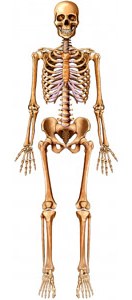Bone fracture
Description bone fracture
Fractures usually occur as a result of injury – drop, twisting, impact or collision. There are different types of bone destruction:
- The bone may be broken, but stay under the skin (simple fracture);
- Bone fragments may come out through the skin (open fracture).
Types of fractures:
- Voucher fracture – a small piece broken off from the main bone;
- Compression fracture – bones strongly pressed together (eg, vertebrae);
- Fracture of bone with fragmentation – the bone is broken into pieces;
- Fracture by type “green branches” – one side of the bone is broken, and the other is bent, but not broken;
- Intra-articular fracture – fracture with joint damage;
- Transverse fracture – the bone is broken in a horizontal plane, perpendicular to the surface of bone marrow;
- Oblique fracture- less bone is broken, than the angle 90 ° to the surface of bone marrow;
- Spiral fracture – the fracture line forms a spiral;
- Stress fracture – destruction occurs due to excessive load on the muscles, passing on bone.

Causes of bone fracture
Fractures of the bones causing injury. The cause of the injury can be:
- Drop;
- Twisting;
- Pounding;
- Clashes.
Injury occurs, when the bone affects exercise, where it can not withstand. Large bones can withstand great physical exertion, smaller than.
Risk factors for bone fracture
Factors, that can increase the risk of bone fracture include:
- Advanced age;
- Postmenopausal;
- Reduced muscle mass;
- Osteoporosis – decrease in bone mass, that weakens bones;
- Some congenital bone disease (rarely);
- Admission glitazone (preparation, used for the treatment of diabetes 2 type);
- Accident or violence.
Symptoms of bone fracture
Symptoms include fracture:
- Pain, often severe (the main symptom);
- The instability of the tissues around the fracture;
- Inability to use the limb or affected area (Sometimes the fracture can be fully functional or partially restricted in movement);
- Swelling or bruising, which is caused by bleeding from the bone and surrounding tissues;
- Numbness, caused by damage surrounding nerves (rarely);
- Fainting or even shock (rarely, Only in severe injury).
Diagnosis of bone fracture
The doctor will ask about your symptoms, About, you are injured, and examines the damaged area.
Tests may include:
- Roentgen – to see the broken bone in the picture;
- CT – used computer X-rays, to make pictures of structures inside the body;
- MRT – It uses a strong magnetic field and radio waves, to make pictures of structures inside the body;
- A bone scan – It is typically used to find the fracture stress.
Treatment of bone fracture
Treatment includes:
- Folding bone parts together (may require anesthesia and / or surgery);
- Saving a stationary position the injured area, until the bone is not very srastetsya.
Devices, which can keep the bone in place, until it heals:
- Gypsum (It can be used with or without surgery);
- Metal pins across the bone (It requires surgery);
- Metal plate with screws (It requires surgery);
- Screws without additional retaining elements (It requires surgery);
- The bar in the middle of the bone (It requires surgery).
The healing and rehabilitation of bone fracture
Healing time ranges from three weeks for a simple finger fracture, to many months for a complicated fracture of long bones.
All fractures require rehabilitation exercises performance, that allows to restore muscle strength and range of motion of the affected body part.
Possible complications of bone perlomah
- Long fusion – splicing and bone healing takes longer than usual, but eventually fracture healing;
- Non-union – bone does not heal and needs special treatment;
- Infection – most often occurs after an open fracture or surgery;
- Damage to nerves or arteries – usually it occurs as a result of severe trauma;
- Compartment syndrome – severe swelling in the extremities, which damages the tissues of the body;
- Arthritis – may, if the surface of the joint is badly damaged.
If you are diagnosed with a fracture, Follow your doctor's instructions.
Prevention of bone fractures
To reduce the risk of bone fracture:
- Avoid situations, which can lead to injury of bones;
- Eat a diet, rich in calcium and vitamin D;
- It is necessary to exercise regularly to strengthen bones;
- You want to perform strengthening exercises, to strengthen muscles and prevent falls;
- Patients with osteoporosis are advised to take the medicine with bisfosfonatami.
